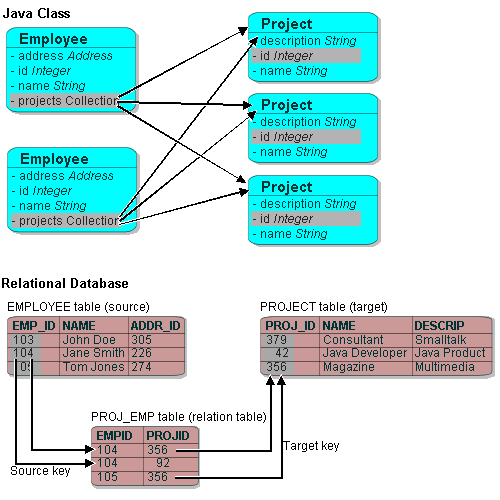Notice: This Wiki is now read only and edits are no longer possible. Please see: https://gitlab.eclipse.org/eclipsefdn/helpdesk/-/wikis/Wiki-shutdown-plan for the plan.
EclipseLink/UserGuide/JPA/Basic JPA Development/Mapping/Relationship Mappings/Collection Mappings/ManyToMany
EclipseLink JPA
| EclipseLink | |
| Website | |
| Download | |
| Community | |
| Mailing List • Forums • IRC • mattermost | |
| Issues | |
| Open • Help Wanted • Bug Day | |
| Contribute | |
| Browse Source |
![]() Key API
Key API
![]() Examples
Examples
Many-to-Many Mapping
Many-to-many mappings represent the relationships between a collection of source objects and a collection of target objects. They require the creation of an intermediate table for managing the associations between the source and target records.
This figure illustrates a many-to-many mapping in Java and in relational database tables.
Many-to-many Relationships
![]()
Note: For the projects attribute shown in the Many-to-many Relationships you can use a Collection interface (or any class that implements the Collection interface) for declaring the collection attribute.
JPA Mapping
By default, JPA automatically defines a ManyToMany mapping for a many-valued association with many-to-many multiplicity.
Use the @ManyToMany annotation to do the following:
- configure the Fetch Type to EAGER;
- configure the mapping to forbid null values (for nonprimitive types) in case null values are inappropriate for your application;
- configure the associated target entity because the Collection used is not defined using generics;
- configure the operations that must be cascaded to the target of the association (for example, if the owning entity is removed, ensure that the target of the association is also removed).
| Attribute | Description | Default | Required? |
|---|---|---|---|
| cascade | – By default, JPA does not cascade any persistence operations to the target of the association.If you want some or all persistence operations cascaded to the target of the association, set the value of this attribute to one or more CascadeType instances, including the following:
|
An empty javax.persitence.CascadeType array | No |
| fetch | – By default, EclipseLink persistence provider uses a fetch type of javax.persitence.FetchType.LAZY: this is a hint to the persistence provider that data should be fetched lazily when it is first accessed (if possible). If the default is inappropriate for your application or a particular persistent field, set fetch to FetchType.EAGER: this is a requirement on the persistence provider runtime that data must be eagerly fetched.. |
javax.persitence.FetchType.LAZY | No |
| mappedBy | By default, if the relationship is unidirectional, EclipseLink persistence provider determines the field that owns the relationship. If the relationship is bidirectional, then set the mappedBy element on the inverse (non-owning) side of the association to the name of the field or property that owns the relationship, as the @ManyToMany Annotation - Project Class with Generics example shows. |
No | |
| targetEntity | By default, if you are using a Collection defined using generics, then the persistence provider infers the associated target entity from the type of the object being referenced. Thus, the default is the parameterized type of the Collection when defined using generics. If your Collection does not use generics, then you must specify the entity class that is the target of the association: set the targetEntity element on owning side of the association to the Class of the entity that is the target of the relationship. |
No |
The @ManyToMany Annotation - Employee Class with Generics example and the @ManyToMany Annotation - Project Class with Generics example show how to use this annotation to configure a many-to-many mapping between Employee and Project using generics.
Example: @ManyToMany Annotation - Employee Class with Generics
@Entity public class Employee implements Serializable { @Id private int id; private String name; @ManyToMany @JoinTable(name="EMP_PROJ", joinColumns= @JoinColumn(name="EMP_ID"), inverseJoinColumns= @JoinColumn(name="PROJ_ID") ) private Collection<Project> projects; ... }
![]()
Note: Use a @JoinTable annotation to define a many-to-many join table; if you do not specify this annotation, EclipseLink will default to @JoinTable with the join table name format of <source-table-name>_<target-table-name> in uppercase characters, and with columns format of <source-entity-alias>_<source-primary-key-column>, <source-field-name>_ <target-primary-key-column> (or <source-property-name>_ <target-primary-key-column>) in uppercase characters.
For more information, see Section 11.1.23 "JoinTable Annotation" in the JPA Specification.
Example: @ManyToMany Annotation - Project Class with Generics
@Entity public class Project implements Serializable { ... @ManyToMany(mappedBy="projects") public Set<Employee> getEmployees() { return employees; } ... }
For more information, see Section 11.1.25 "ManyToMany Annotation" in the JPA Specification.

